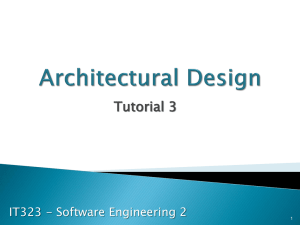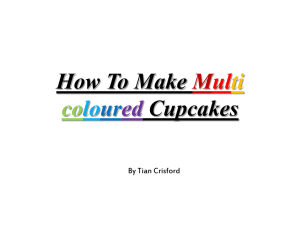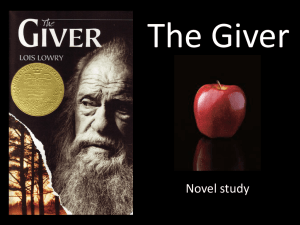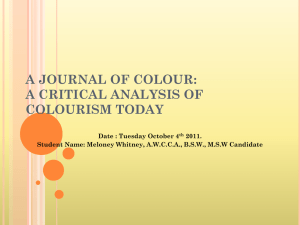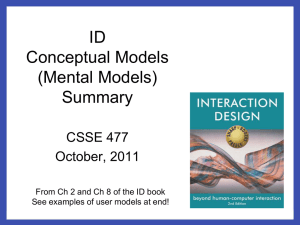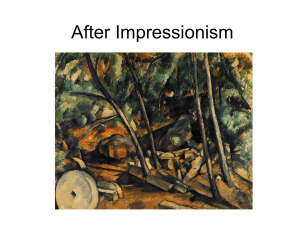People: psychological and physiological constraints
advertisement
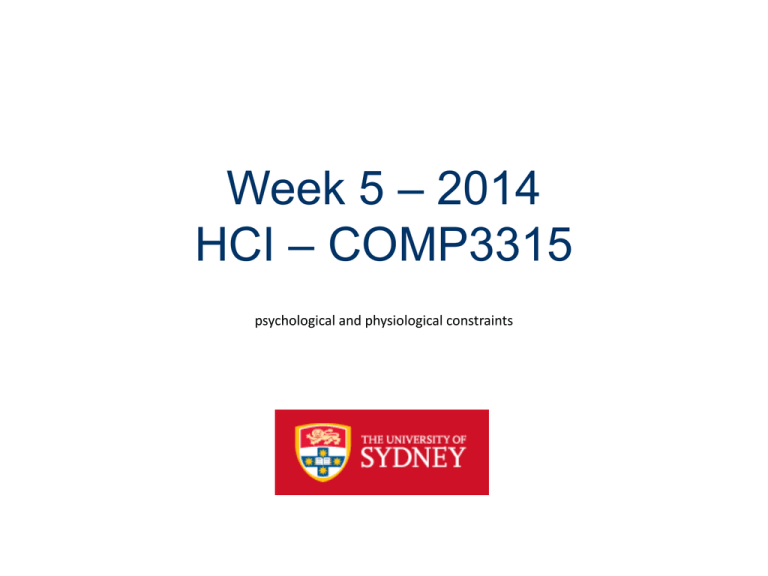
Week 5 – 2014 HCI – COMP3315 psychological and physiological constraints People: psychological and physiological constraints First Principles of Interaction Design (Revised & Expanded) March 2014 http://asktog.com/atc/principles-ofinteraction-design/ A challenge for HCI lectures… lecture notes versus the experience People learn more if they engage eg have to click to see the information, have to think about issues and use information rather than just read it. Human cognition…. Impact on assignment Overview • Thinking about people – Cognitive – Physical – Physiological • Some theories and terms – – – – • • Mental models Gulf of execution Conceptual models Fitts’ Law Some very fine-grained guidelines, useful for design and for no-user Heuristic Evaluation Importance of empirical validation of all theories Mental models Definitions, links to most other parts of HCI, valuable language and mental tools Mental models http://www.nngroup.com/articles/mental-models/ • Summary: What users believe they know about a UI strongly impacts how they use it. Mismatched mental models are common, especially with designs that try something new. • Definition: A mental model is what the user believes about the system at hand. • Note: – – – – Beliefs …. Not facts Mental models drive predictions, planning actions Individual MMs differ …. Designer MM versus “user” MM MMs change…. Implications for One Sentence Statement Example: “Cannot save file…. No space” Mental models…. • • • • What was the user’s mental model? What is the designer’s (actual) system model Cause of the problem??? How to overcome it??? • In this case • In general The refrigerator challenge • Your refrigerator’s freezer section is not cold enough • You find a dial at the back of the freezer labelled as below and set on 3 – warmer 1 2 3 4 5 6 7 colder • What will you do? Will it work? What is your mental model? Neilsen on MM • ….many less-techy users don't understand the differences between many other common features: – – – – – – Operating-system windows vs. browser windows A window vs. an application, Icons vs. applications, Browser commands vs. native commands in a Web-based app Local vs. remote info Different passwords and log-in options (users often log in to other websites as if they were logging in to their email) • Implications for – usable security? – Building on metaphors How to address… • “Make the system conform to users' mental models — …. This is the approach we usually recommend to fix IA problems: – eg If people look for something in the wrong place, then move it to the place where they look for it. – Card sorting is a useful way to discover users' mental model of an information space so that you can design your navigation accordingly. • Improve users' mental models so that they more accurately reflect your system. – eg explaining things better – making labels clearer to make the UI more transparent (even though the underlying system remains unchanged). Some useful distinctions • Slips: – correct user model, inadvertent incorrect action – eg car “malfunction”, tap caps lock accidentally • Mistakes: incorrect mental model • Use this tightened vocabulary for your thinkaloud reports Norman’s Gulf of Execution http://learnline.cdu.edu.au/units/hit381/resources/popups/normantheoryof action.html Norman’s Gulf of Evaluation http://learnline.cdu.edu.au/units/hit381/resources/popups/normantheoryof action.html Gulf of evaluation: the amount of effort required to determine the system state When problems occur in the evaluation phase, the "gulf of execution" widens Some examples "What happened then?" "What did I do wrong" User repeats the action (e.g. clicks the NEXT or SUBMIT button) Norman’s Gulf of Execution http://learnline.cdu.edu.au/units/hit381/resources/popups/normantheoryof action.html Gulf of execution….distance between the user's goals and the means of achieving them through the system Some examples: "What do I do now?" "How do I [...]?" "I wanted to [...], but I can't see how I would do that?" "Do I press this?" "Do I type this in here?" "I'm looking for [...] but I can't find it" Norman’s Gulf of Execution http://learnline.cdu.edu.au/units/hit381/resources/popups/normantheoryof action.html Overcoming gulfs - Norman’s questions : Norman, D.A. 1988 "The Design of Everyday Things." MIT Press • How easily can a person determine: – 1 determine the function of the device? – 2 tell what actions are possible? – 3 determine mapping from intention to physical movement? – 4 perform the action? – 5 tell what state the system is in? – 6 tell if system is in desired state? – 7 determine mapping from system state to interpretation? Principles of good design • Provide a good conceptual model – Enables user user to build good mental model of the device. – And to predict the effects of their actions. • Make things visible/audible/tangible – Ensure user can see, hear, feel… the state of the device and the alternatives for action. • The Principle of Mapping – Relies on linking existing mental model to perceived system • Natural mapping • Physical analogies • Cultural standards • The Principle of Feedback – Information on what has been accomplished or is doing. – full and continuous feedback about results of actions. Mental versus conceptual models http://uxmag.com/articles/the-secret-to-designing-an-intuitive-user-experience • “…. a mental model refers to the representation of something—the real world, a device, software, etc.— that the user has in mind. It is a representation of an external reality. Users create mental models very quickly, often before they even use the software or device. Users’ mental models come from their prior experience with similar software or devices, assumptions they have, things they’ve heard others say, and also from their direct experience with the product or device. Mental models are subject to change. Users refer to mental models to predict what the system, software, or product is going to do, or what they should do with it. “… A conceptual model is the actual model [available] to the user through the interface of the product. [eg] iPad ebook … mental model about .. – what reading a book will be like in the iPad, – how it will work, what you can do with it. But when you sit down with the iPad, the “system” (the iPad) will display …. screens, and buttons, and things that happen. The actual interface is representing the conceptual model. Someone designed a user interface and that interface is communicating to you the conceptual model of the product. Case study • Moded interfaces: – The same interface action has a different meaning depending upon the context • Class activity: define some examples of moded interaction in common interfaces eg text editor, Powerpoint, Word • What are the challenges for the user? Redraw this, adding conceptual model, and making changes to correct any errors Challenges for design: • conceptual model doesn’t match the user’s mental model • designers of the conceptual model needs to account for the user’s mental model – How does CI help? – And the role of Think-Aloud? • multiple user groups • conceptual model purely reflects underlying hardware, software or database • creating materials/training to build an appropriate mental model – One Sentence Statement? Returning to Assignment 1 • Why are sketches better for exploring the space of conceptual models? • Some students used software for wireframes and prototyping – why is this dangerous? • Clarity on differences between mental model, conceptual model, actual system Fitts’ Law http://sixrevisions.com/usabilityaccessibility/improving-usability-with-fitts-law/ time …. to complete the action a and b are empirically determined regression coefficients, …..values gained from direct observation that build a slope. distance … from the starting point to the …target object width is the width of the target object http://sixrevisions.com/usabilityaccessibility/improving-usability-with-fitts-law/ http://mindhacks.com/2005/01/20/siz e-and-selection-times-fittss-law/ Age matters http://hcil2.cs.umd.edu/trs/2003-16/2003-16.html Participant in (1) was a 4 year 6 month old female. Participant in (2) was a 5 year 8 month old female. Participant in (3) was a 21 year-old female. http://hcil2.cs.umd.edu/trs/2003-16/2003-16.html All paths taken by 5 year old participants to click on a 32 pixel target at a distance of 256 pixels. http://hcil2.cs.umd.edu/trs/2003-16/2003-16.html All paths taken by adult participants to click on a 32 pixel target at a distance of 256 pixels. Beyond the mouse? Fitts’ Law in action – Grouping, layout, hierarchies http://sixrevisions.com/usabilityaccessibility/improving-usability-with-fitts-law/ Fitts’ Law in action – The prime pixel……where your cursor is now http://sixrevisions.com/usabilityaccessibility/improving-usability-with-fitts-law/ Windows, …. right-click ….contextual menu of options usually appears that has its point of origin at the prime pixel. http://sixrevisions.com/usabilityaccessibility/improving-usability-with-fitts-law/ Magic pixels….. What are they? Fitts’ link? Why are they important? http://sixrevisions.com/usabilityaccessibility/improving-usability-with-fitts-law/ Summary • Empirical foundations • Heuristics for designers – Grouping items for flow of action • Special locations – Prime pixel – Magic pixels A Quiz Designed to Give You Fitts http://www.asktog.com/columns/022DesignedToGiveFitts.html • Microsoft Toolbars offer the user the option of displaying a label below each tool. Name at least one reason why labeled tools can be accessed faster. (Assume, for this, that the user knows the tool and does not need the label just simply to identify the tool.) • You have a palette of tools in a graphics application that consists of a matrix of 16x16-pixel icons laid out as a 2x8 array that lies along the left-hand edge of the screen. Without moving the array from the left-hand side of the screen or changing the size of the icons, what steps can you take to decrease the time necessary to access the average tool? • A right-handed user is known to be within 10 pixels of the exact center of a large, 1600 X 1200 screen. You will place a single-pixel target on the screen that the user must point to exactly. List the five pixel locations on the screen that the user can access fastest. For extra credit, list them in order from fastest to slowest access. • Microsoft offers a Taskbar which can be oriented along the top, side or bottom of the screen, enabling users to get to hidden windows and applications. This Taskbar may either be hidden or constantly displayed. Describe at least two reasons why the method of triggering an auto-hidden Microsoft Taskbar is grossly inefficient. A Quiz Designed to Give You Fitts http://www.asktog.com/columns/022DesignedToGiveFitts.html • Explain why a Macintosh pull-down menu can be accessed at least five times faster than a typical Windows pull-down menu. For extra credit, suggest at least two reasons why Microsoft made such an apparently stupid decision. • What is the bottleneck in hierarchical menus and what techniques could make that bottleneck less of a problem? • Name at least one advantage circular popup menus have over standard, linear popup menus. • What can you do to linear popup menus to better balance access time for all items? • The industrial designers let loose on the Mac have screwed up most of the keyboards by cutting their function keys in half so the total depth of the keyboard was reduced by half a key. Why was this incredibly stupid? • What do the primary solutions to all these questions have in common? Attention Attention • http://www.youtube.com/watch?v=vJG698U2 Mvo&feature=c4-overviewvl&list=PLB228A1652CD49370 • Daniel Simons Attention • Why did this happen? • What is attention? – Visual ** – Audio • What are the implications for UI designers? – Multi-tasking – Attention-grabbers • And for UI evaluations? – Eye tracking – Think-aloud • For your project – Guiding the user in where to attend Memory • Working memory – Miller, George A. "The magical number seven, plus or minus two: some limits on our capacity for processing information." Psychological review 63.2 (1956): 81. (>17K gcites, Sep 2013) http://cogprints.org/730/1/miller.html – WM very limited – Chunking is really important – Complex to user this to predict … but may explain thinkaloud observations – (Claude Shannon theory of information .. Brain as information processing machine) • Long term memory – Critical for recall at UI – And learning about UI – Mental model Perception • Translating external stimuli into the memory – Senses – Processing their information – Tightly interlinked physical and cognitive • Simple example, reading a screen – Vision… visibility Screen design • • • Tullis, Thomas S. "The formatting of alphanumeric displays: A review and analysis." Human Factors: The Journal of the Human Factors and Ergonomics Society 25.6 (1983): 657-682. http://www.eastonmass.net/tullis/publications/1983HF/FormattingAlphanumericDisplays.pdf Key outcomes in terms of – Performance versus affect (preferences) – Density (local/overall), grouping, layout complexity – Grouping related elements, organised for vertical scanning, with space between them aids search in speed and preference • Science of screen design – – – – – – – Careful empirical studies Design of initial study Replication Impact of different technology Impact of the particular task Impact of user’s mental model, standards for device, application Translation to your interface Colour • Valuable for screen design – Performance ++ – Affect ++ • Well understood challenges that are avoidable but failure to do so can compromise performance Tog Principles http://asktog.com/atc/principles-of-interaction-design/ • “Principle: Any time you use color to convey information in the interface, you should also use clear, secondary cues to convey the information to those who cannot see the colors presented • Principle: Test your site to see what color-blind individuals see • Principle: Do not avoid color in the interface just because not every user can see every color. • Principle: Do not strip away or overwhelm color cues in the interface because of a passing graphic-design fad. Colour blindness • Affected ~ 8% of men, .5% women • Tetsting tools eg – http://enably.com/chrometric/. • For images images – http://www.colblindor.com/coblis-colorblindness-simulator/. • xxxx Coblis — Color Blindness Simulator Their demo: normal vision Green-Blind/Deuteranopia Blue-Blind/Tritanopia Red-Blind/Protanopia Normal vision Blue-Weak/Tritanomaly What can you do about colour blindness? • Be aware! • Design in black and white and add colour sparingly • What else? …. Class activity Colour • Valuable for screen design – Performance ++ – Affect ++ • Well understood challenges that are avoidable but failure to do so can compromise performance Coding • Means distinguishing different parts of an interface • Includes – Font changes such as these – Font with style and size – – – – Use of colour such as here and here – seriously Special symbols, shapes Sound Movement • All are about ... Coding • Means distinguishing different parts of an interface • Includes – Font changes such as these – Font with style and size – – – – Use of colour such as here and here – seriously Special symbols, shapes Sound Movement • All are about ... gaining attention Colour can be poorly used • Means distinguishing different parts of an interface • Includes – Font changes such as these – Font with style and size – Use of colour such as here and here – seriously – Special symbols, shapes – Sound – Movement • All are about ... gaining attention HAI2008. Lifelong ambient companions: challenges and steps to Stroop effect http://faculty.washington.edu/chudler/java/ready.html Stroop Effect From http://faculty.washington.edu/chudler/words.html Colour • Properties – Hue – wavelength (red .. violet) – Saturation, chroma (purity, mix of wavelengths) • High saturation very pure • Low saturation, greyish – Brightness, intensity, value • very low intensity becomes black Visible Spectrum Winter 2013 CSE 440: User Interface Design, Prototyping, and Evaluation 68 Physiology and colour • Rods and cones • Fovea – detailed vision (eg text) • Only cones sensitive to colour – 64% respond to red – 32% to green – 2% to blue (none in fovea!) • Opposing colours at the neuron level – Red-green, yellow-blue • Visual acuity reduced for violet end of spectrum • Insensitivity to blue increases with age • Blue seems harder to read, especially on some backgrounds • With normal light, we see mid-spectrum colours best (ie green, yellow) • Colour blindness – 8% men, 0.4% women – Use additional redundant cue eg colour + box + brightness difference and this improves broad performance • Reds appear closer than blues • Warm colours appear larger than cool colours – eg red larger than blue • Blooming effect – Light colours on dark backgrounds appear larger • Colours distant on spectrum require refocusing • After images and shadows can follow – Opposing colours – Highly saturated colours • Illumination matters too Light text on a dark background Dark text on a light background Light text on a dark background Dark text on a light background Blooming – light text on dark background seem larger Red text on a dark background Red text on a light background Red text seems to focus differently Red text seems to focus differently Red text seems to focus differently Red text seems to focus differently Red text seems to focus differently Red text seems to focus differently So many ways to make mistakes... Color Guidelines Avoid simultaneous display of highly saturated, spectrally extreme colors – e.g., no cyans/blues at the same time as reds, why? • refocusing! – desaturated combinations are better pastels Winter 2013 CSE 440: User Interface Design, Prototyping, and Evaluation 80 Using the Hue Circle • Pick non-adjacent colors – opponent colors go well together • (red & green) or (yellow & blue) Winter 2013 CSE 440: User Interface Design, Prototyping, and Evaluation 81 Guidelines eg http://colorusage.arc.nasa.gov/guidelines.p hp Examples: • Pure blue shall not be used on a dark background for text, thin lines, or high resolution information. [Source: DOE-HFAC 1, 1992] FAA Human Factors Design Standard, p 8-58 • 8.6.2.2.7 Blue. Blue should not be used as the foreground color if resolution of fine details is required. [Source: DOD HCISG V2.0, 1992] FAA Human Factors Design Standard, p 8-57. • http://colorusage.arc.nasa.gov/assets/blue_1.gif More examples from NASA: from http://colorusage.arc.nasa.gov/guidelines_discrim_id.php • Use no more than six colors to label graphic elements. • Use colors in conformity with cultural conventions. • Use color coding consistently across displays and pages • Use color coding redundantly with other graphic dimensions. • Don't use color coding on small graphic elements Recommendations • Use colour sparingly • Maximum codings 5 (+ or – 2) matching short term memory • Design in monochrome first • Optimise all other aspects of design and layout • Add colour (with awareness of problems) • Use colour to: – Draw attention (better than shape, size, brightness) – Show organisation, status, relationships cont • With black foreground, use cyan, magenta, white • Ensure contrast ib hue and brightness of foreand background • • • • Allow users to control colour coding Use colour consistently across system Use other (redundant) cues as well Avoid saturated blue for small text and thin lines Blinking and movement When is it good? And not? Take yourself back to hunter and gatherer times: A hungry tiger is coming from the distance at your right Blinking and movement • Hard to ignore • Reduces legibility • Can be really annoying • Helpful for tiny cursors (otherwise hard to find and large ones are obtrusive) • Helpful for critical situations Shapes • Conventions for some shapes – eg warning and errors • Special shapes – eg little hand pointing • Cultural boundaries Summary • Awareness of human factors affecting design • Awareness of some basic guidelines for use of colour – Apply these for a simple form of no-user testing by checking your UI against guidelines – Better done by person other than designer (role for your teams to desk-check each other’s designs)




